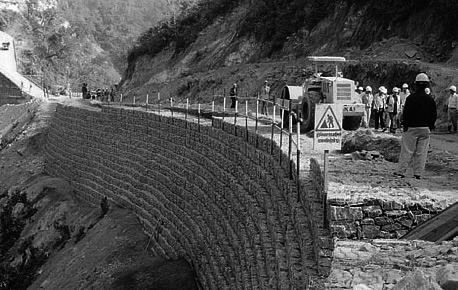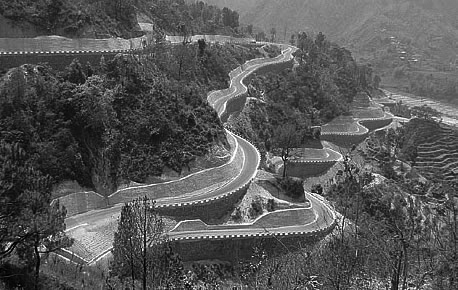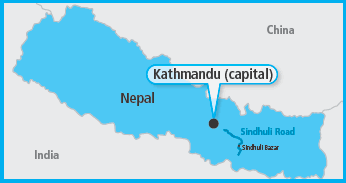Japan's Official Development Assistance White Paper 2009
Column 5 Taking on the Challenge of Mountain Roads with Japanese Technique
— The "Stone Wall" Road in Nepal —
"How should we build a road through these jungle-covered mountains?" These are the words of Mr. Hiroki Shinkai of consultant firm, Nippon Koei Co., LTD. when he was selecting a route through the steep Mahabharat Range at the altitude range of 1,500 m. The road, named Sindhuli Road after a village that it passes through at the foot of these mountains, is a highway connecting Nepal's capital Kathmandu and the eastern Tarai region near the border with India. Nepalese had expected for such a road for a long time.
Japan has provided consistent cooperation for this project since the very beginning of surveys until today's construction work. In March 2009, the difficult No. 2 Section was completed, and all lanes of the road are scheduled to open in five years with the completion of the remaining No. 3 Section. The completed No. 1 Section, No. 2 Section, and No. 4 Section are already in use.
The arterial highway, which connects the commercial and industrial city Kathmandu with the agricultural production region of the eastern Tarai, will provide convenience to people living near the road and will be extremely important in improving Nepal's economy. When the road is opened, it is expected to transport persons in need of immediate medical attention to hospitals by ambulance, and by the sale of agricultural products in Kathmandu and other cities to increase the incomes of farmers. Since the transportation time of food and medicine becomes much shorter, the prices of such items will decrease by as much as 30% in some regions, and it is just like the Nepalese saying, "a land with roads is wealthy."
The Sindhuli Road benefits the people in various ways, but there have been many hardships and difficulties in its construction. The construction of the road has taken place by transferring Japan's mountain road construction technique to Nepal. At first, those involved in the project from Japan were puzzled by the major differences in the ways of thinking of the engineers and construction workers working at the sites in regard to daily living habits and different views on safety. For example, at the start of construction, the Nepalese workers initially hesitated to wear helmets. The Japanese engineers persistently emphasized to them the importance of safety, and as a result, almost all of the workers came to wear helmets and fasten the chin strap. The Japanese engineers thus also had a positive impact regarding the ensuring of safety of the people involved in construction.
With a view toward building an "environmentally-friendly road" and generating employment for the local people, rocks and abundant cobbles were used in road construction since such materials can be acquired almost anywhere and are easy for local workers to use. In consequence, the completed road has an appearance similar to the stone walls of traditional Japanese castles. The Sindhuli Road was thus built while making an effort to match traditional Japanese techniques with the natural conditions of Nepal.
Mr. Toshio Iizuka of Hazama Taisei JV (a joint venture group) comments, "We came up with the idea of making such stone walls by referring to Japanese castle construction techniques. The materials could be acquired locally, so we were able to reduce costs, and by having local people participate in the construction, we were able to generate employment."
While thirteen years have passed since the construction of the Sindhuli Road began in 1996, the parties concerned are continuing to make efforts for the goal of opening all lanes in five years. If you have a chance to visit the road, you may feel the devotion of Japanese engineers to build a good road based on the idea of matching traditional Japanese techniques with Nepal's natural setting.

Stone wall utilizing local materials. (Photo: Nippon Koei Co., Ltd.)

Sindhuli Road similar in appearance to a stone wall. (Photo: Nippon Koei Co., Ltd.)

